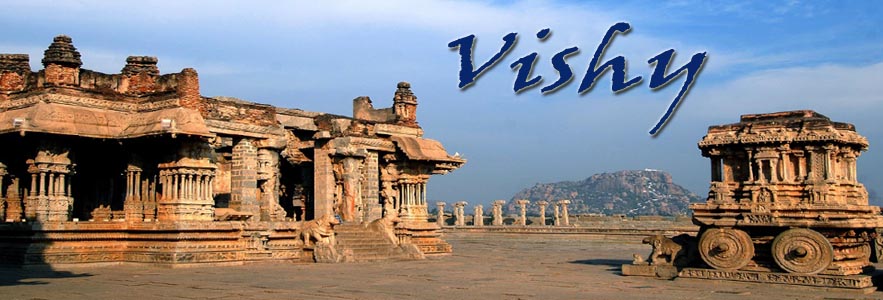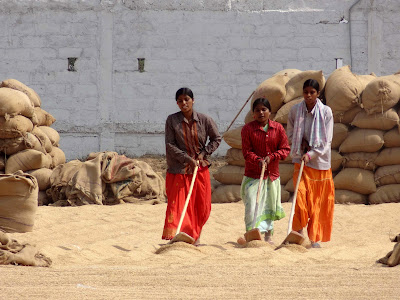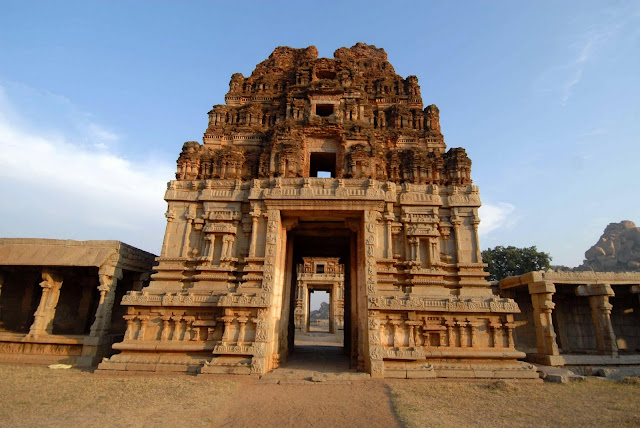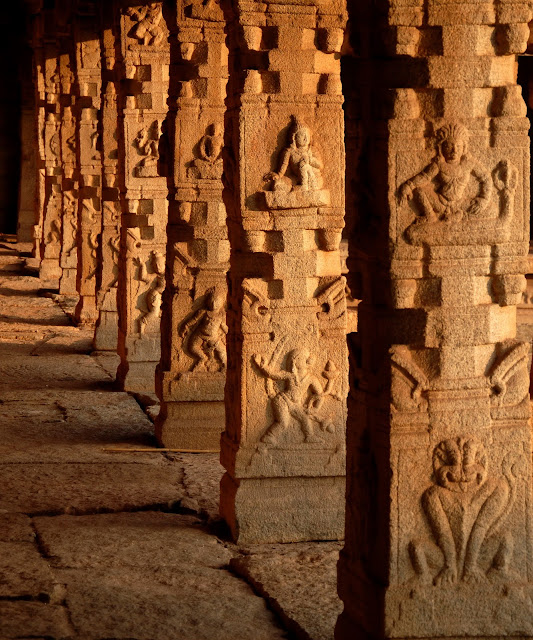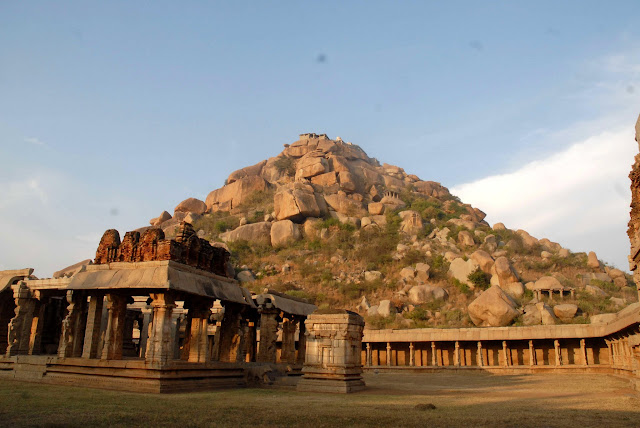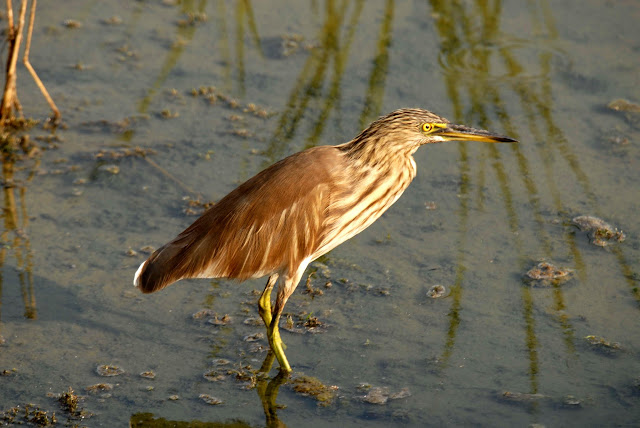A PHOTO TRAVELOGUE TO ANEGUNDI-HAMPI
Myself and Sateesh left Bangalore on 20th Dec 2011, at 11-30 pm by bus on an 8 hour journey and reached Gangavathi, and moved towards Circuit house.
About Gangavathi:
Gangavathi is a town and a municipal council in Koppal district in the state of Karnataka, India. Gangavathi is an important commercial centre. Hampi, a well known UNESCO World Heritage Site is 14 km from the town. Other places of historical importance include Anegundi, Kanakagiri, and Hemagudda. Gangavathi was one many talukas in Raichur District. When Koppal district was carved out of Raichur District, Gangavathi became part of Koppal district.
Gangavathi is famous for rice cultivation, and considered the rice bowl of Karnataka.It is famous for rice milling industry. Many films have been shot in Gangavathi like China Gate, Amaanat, Nayak.
Info about Rice
 Rice (genus Oryza) is tolerant to desert, hot, humid, flooded, dry and cool conditions, and grows in saline, alkaline and acidic soils. Of 23 Oryza species, two are cultivated: Oryza sativa (left), which originated in the humid tropics of Asia, and O. glaberrima, from West Africa. Asian cultivated rice has evolved into three eco-geographic races-indica, japonica and javanica Rice is life for thousands of millions of people. It is deeply embedded in the cultural heritage of their societies. It is the staple food for more than half of the world population. In Asia alone, more than 2,000 million people obtain 60 to 70 percent of their calories from rice and its products. It is the most rapidly growing source of food in Africa, and is of significant importance to food security in an increasing number of low-income food-deficit countries.
Rice (genus Oryza) is tolerant to desert, hot, humid, flooded, dry and cool conditions, and grows in saline, alkaline and acidic soils. Of 23 Oryza species, two are cultivated: Oryza sativa (left), which originated in the humid tropics of Asia, and O. glaberrima, from West Africa. Asian cultivated rice has evolved into three eco-geographic races-indica, japonica and javanica Rice is life for thousands of millions of people. It is deeply embedded in the cultural heritage of their societies. It is the staple food for more than half of the world population. In Asia alone, more than 2,000 million people obtain 60 to 70 percent of their calories from rice and its products. It is the most rapidly growing source of food in Africa, and is of significant importance to food security in an increasing number of low-income food-deficit countries.
Info about Rice
 Rice (genus Oryza) is tolerant to desert, hot, humid, flooded, dry and cool conditions, and grows in saline, alkaline and acidic soils. Of 23 Oryza species, two are cultivated: Oryza sativa (left), which originated in the humid tropics of Asia, and O. glaberrima, from West Africa. Asian cultivated rice has evolved into three eco-geographic races-indica, japonica and javanica Rice is life for thousands of millions of people. It is deeply embedded in the cultural heritage of their societies. It is the staple food for more than half of the world population. In Asia alone, more than 2,000 million people obtain 60 to 70 percent of their calories from rice and its products. It is the most rapidly growing source of food in Africa, and is of significant importance to food security in an increasing number of low-income food-deficit countries.
Rice (genus Oryza) is tolerant to desert, hot, humid, flooded, dry and cool conditions, and grows in saline, alkaline and acidic soils. Of 23 Oryza species, two are cultivated: Oryza sativa (left), which originated in the humid tropics of Asia, and O. glaberrima, from West Africa. Asian cultivated rice has evolved into three eco-geographic races-indica, japonica and javanica Rice is life for thousands of millions of people. It is deeply embedded in the cultural heritage of their societies. It is the staple food for more than half of the world population. In Asia alone, more than 2,000 million people obtain 60 to 70 percent of their calories from rice and its products. It is the most rapidly growing source of food in Africa, and is of significant importance to food security in an increasing number of low-income food-deficit countries. The god Shiva called rice Vrihi, in Sanskrit. India is one of the original centres of rice cultivation. The rice harvesting area in India is the world's largest. Indian rice cultivation is found in all states, but West Bengal, Uttar Pradesh, Madhya Pradesh, Orissa and Bihar are the major producing states.
The early Kharif growing season lasts from March-May to June-October; the mid-Kharif season from June-October to November-February, and the Rabi season from November-February to March-June.
About 600 improved varieties of indica rice have been released for cultivation since 1965, but Basmati rice is still planted over large areas. Rice-based production systems provide the main income and employment for more than 50 million households. Rice is the staple food for 65% of the total population in India. The Indian population was about 1 billion people in 2000 and is still growing at a high rate (1.7% per year). Although the country exports several varieties of rice, many scientists have expressed concern that current Indian rice production techniques cannot sustain the growing domestic population. India has a large number of rice dishes and many of them are very simple to prepare. Indian pilaf rice is very flavourful and fluffy when cooked with Basmati rice.
Historical places in and around Gangavathi
There are many historical places around Gangavathi namely Male Mallappana Gudda, Vanabhadrashwar gudda, Deva Ghat, Annegundi, Adishakthi Temple, Hemma Gudda, Kumara Rama Caves and Fort, Chinthamani, Nava Brindavana, Pampasarovara Mahalaxmi Temple, Anjaneya Gudda, Siddapur Gaddi now called Om beach and Kishkinda Heritage resort. Hirejantkal Sri Pampapati temple, Sri Kannikaparmeshwari temple, Sri Eranna temple, Guladal(Camp)Kariyappa tata And Bandi Hanumanth Temple, Kanakagiri Venkatachalapathi Temple, Venkatagiri Sri Laxmi Venkateshwara temple, Saibaba temple in Bassapattana, Sri Channabasava Swamy Math, Sri Ram Tempple, Sai Temple, Kalmath are the places to Visit- Jagavathi Veeresh Hiremath & Rachotayya Jagavati.
Info about Anegundi
Anegundi, older than Hampi, is situated on the northern bank of Tungabhadra River. Huchappayana matha temple (with black-stone pillars and dance sculptures), Pampa Sarovara, Aramane (a ruined palace), Ranganatha temple,Kamal Mahal, and Navabrindavan are the major attractions. Nimvapuram, a nearby village, has a mount of ash believed to be the cremated remains of monkey king Vaali.
It is said to have one of the oldest plateaus on the planet, estimated to be 3,000 million years old. So, only local story-tellers refer to Anegundi as the maternal home of Bhoodevi (Mother Earth).
Anegundi, believed to be the monkey kingdom of Kishkindha in the epic of Ramayana, is at a distance of 5 km from the historical site of Hampi. Anjanadri hill, the birth place of monkey-god Hanuman, and the mountain Rishimuka are the other places near Anegundi associated with Ramayana.
Anegundi is one of the Village in Gangavathi Taluk in Koppal District in Karnataka State. Anegundi is located 8.5 km distance from its Taluk Main Town Gangavathi. Anegundi is 36.8 km far from its District Main City Koppal. It is 290 km far from Bangalore.
Wooden Charriot at Ranganatha Temple in Anegundi
Gagan Mahal Palace at Anegundi
Anegundi which literally means elephant pit in Kannada, is a small village in Koppal district of Karnataka state, located on the north banks of the Tungabhadra River on the opposite bank of the Vittala Temple. Anegundi was the original capital city of the Vijayanagara Empire when Mohammad Tughlaq, Sultan of Delhi, defeated the King of Anegundi (Jambukeshwara Raya) and appointed Malik Nayab as his representative to rule over the city. During this time the brothers Hakka and Bukka organised a group following Vidyaranya's advice that successfully recaptured Anegundi without bloodshed by sneaking into the Anegundi fort and taking Malik Nayab prisoner while he was drunk. Later on, Hakka and Bukka (along with the help of Vidyaranya) found the Vijayanagara Empire with Anegundi as its capital, though it was moved to nearby Vijayanagara in northern Karnataka as the empire continued to expand.
| The Footprints of Rama at the Spot where he aimed and shot at Vaali |
Just across the Tungabhadra river is the fortress town of Anegundi, pre-dating the Vijayanagara Empire and its capital city. More anscient than Hampi, Anegundi lies in the mythical kingdom of Kishkinda, ruled by the monkey-king Sugriva of the Ramayana fame. Anjanadri Hill, near Anegundi, is believed to be the birthplace of the monkey god Hanuman. Anegundi and its tranquil environs are dotted with forgotten temples and fortifications. The dilapidated Huchappayana Matha Temple, near the river, is worth a peek for its black stone lathe turned pillars and fine panels of dancers. The other places of interest are the sacred Pampa Sarovara, Aramane (a ruined palace) and the Ranganatha Temple, Adishakthi Temple, Hemma Gudda, Kumara Rama Caves and Fort, Chinthamani, first we visited Chintamani after visiting Kumara Rama caves, we moved to Adishakti temple
|
Sri Rama Penance Place in Chitamani
 |
| Lord Rama resting Place |
 |
| View of Tungabhadra River |
 |
| Sita Mata's place at Kumara Rama Caves |
 |
| ANOTHER VIEW OF TB RIVER |
Day-02 : 22nd Dec 2011- Gangavathi-Hospet-Hampi-Virupaksha Temple-Daroji Bear Park-Hospet
At 5-30 am left early from Gangavathi Circuit House, caught a autorickshaw to Gangavathi Bus Stand, from there we travelled to Hospet by local KSRTC bus, reached Hospet, the road condition from Gangavathi to Hospet is very bad. it took nearly 1 hr 25 mts to cover 40 kms, reached Amaravthi PWD Guest house, had tea and left for darshan of Lord Virupaksha and started our photo shoot from there.
HAMPI:
Hampi is charismatic even in its ruined state. It attracts thousands of tourists and pilgrims every year. Vast stretches of boulder-strewn hills make the backdrop of Hampi unique. Dotted around the hills and valleys are 500 plus monuments. The ruins of the empire is spread over the area of 26 sq km, Among them are beautiful temples, basements of palaces, remains of aquatic structures, ancient market streets, royal pavilions, bastions, royal platforms, treasury buildings.., the list is practically endless. Hampi is a backpackers paradise, the same way the pilgrims delight.
Before the fall of Vijayanagar empire, diamonds were sold on the streets. The main street selling diamonds and other precious stones, was surprisingly called Pan Supaari Street (translated in english it means betel-leaf betel-nut street). A visitor can still see the exact location of Pan Supaari Street in Hampi,
In Hampi at every turn there is a surprise. Every monument hides more than what they reveal. As an open museum, Hampi has numerous popular (100 plus!) locations visitors throng.
Amidst an awesome boulder-strewn landscape along the banks of the Tungabhadra river, Hampi was one of the glittering showpieces of India's might in the 15th century. There were opulent palaces, marvellous temples, massive fortifications, baths, markets, pavilions and stables for royal elephants. The city's merchants traded in diamonds, pearls, fine silks, brocades, horses and much more.
Virupaksha Temple: Dedicated to Lord Shiva and his consort Pampadevi, this is the only temple here that is still used for worship. Parts of the temple predate the Vijayanagara empire. The temple, with its nine storied gopuram, towers above the other structures at Hampi. The ceiling of the Ranga Mantapa is beautifully painted with scenes from the epics and Puranas.
Virupaksha Temple is located in Hampi 350 km from Bangalore, in the state of Karnataka in southern India. It is part of the Group of Monuments at Hampi, designated a UNESCO World Heritage Site. Virupaksha is a form of Shiva and has other temples dedicated to him, notably at the Group of Monuments at Pattadakal, another World Heritage Site.
 |
| VIRUPAKSHA TEMPLE GOPURAM |
Hampi sits on the banks of the Tungabhadra River in the ruins of the ancient city of Vijayanagar, capital of the Vijayanagara empire. Virupaksha Temple is the main center of pilgrimage at Hampi and has been considered the most sacred over the centuries. It is fully intact among the surrounding ruins and is still used in worship. The temple is dedicated to Lord Shiva, known here as Virupaksha, as the consort of the local goddess Pampa who is associated with the Tungabhadra River. There is also a powerful Virupakshini amma temple (mother goddess) in a village called Nalagamapalle, Chittoor district, Andhra Pradesh, approximately 100 km from Tirupati.
 |
| VIRUPAKSHA TEMPLE |
Temple structure At present, the main temple consists of a sanctum, three ante chambers, a pillared hall and an open pillared hall. A pillared cloister, entrance gateways, courtyards, smaller shrines and other structures surround the temple.
 |
| VIRUPAKSHA TEMPLE- INNER VIEW |
 |
| VIRUPAKSHA TEMPLE FROM PUSHKARNI |
The nine-tiered eastern gateway, which is the largest at 50 meters, is well-proportioned and incorporates some earlier structures. It has a brick superstructure and a two-tiered stone base. It gives access to the outer court containing many sub-shrines.
The smaller eastern gateway leads to the inner court with its numerous smaller shrines. A narrow channel of the Tungabhadra River flows along the temple's terrace and then descends to the temple-kitchen and out through the outer court.
 |
| KALYANA MANTAPA |
Krishnadevaraya, one of the famous kings of the Vijayanagara Empire was a major patron of this temple. The most ornate of all structures in the temple, the central pillared hall is believed to be his addition to this temple. So is the gateway tower giving access to the inner courtyard of the temple. Inscriptions on a stone plaque installed next to the pillared hall explain his contribution to the temple. It is recorded that Krishna Devaraya commissioned this hall in 1510 AD.
 |
| BHOJANA SHALE (DINING HALL) |
 |
| ANOTHER VIEW OF BHOJANA SHALE, (DINING HALL) |
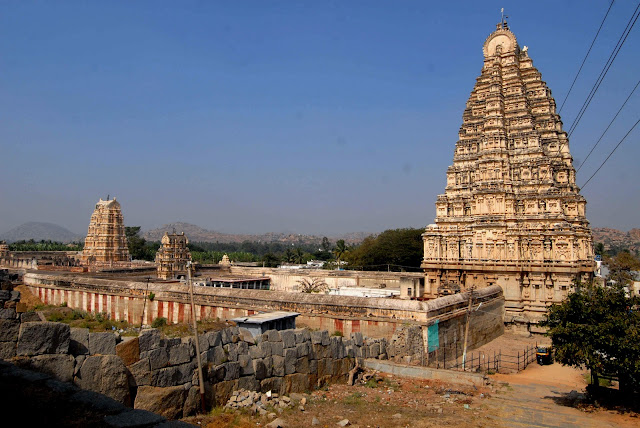 |
| VIRUPAKSHA TEMPLE VIEW FROM HEMA KUTA HILL |
 |
| TOURISTS RELAXING AT HEMA KUTA HILL BACKDROP VIRUPAKSHA TEMPLE |
 |
| JAIN TEMPLE, HEMA KUTA HILL |
 |
Festivals
The temple continues to prosper and attracts huge crowds for the betrothal and marriage festivities of Virupaksha and Pampa in December. In the month of February the annual chariot festival is celebrated here.
Ganesha Images: Two Ganesha images(Sasuvekalu and Kadalekalu) can be seen on the slopes of the Hemakuta Hill. One of them is enclosed in a temple with unusally tall pillars, while the other is in an open hall.
 |
| Kadlekai Ganesha- Hampi |
 |
| Panorama View from Mahanavami Dibba |
 |
| Mahanavami Dibba, built to commemorate victories during their period |
 |
| Panorama View of Mahanavami Dibba |
 |
| Panorama View of Mahanavami Dibba |
Stepped Tank near the Underground Temple
Daroji Sloth Bear Sanctuary
Welcome to Daroji Sloth Bear Sanctuary. Locally known as KARADI, the Sloth Bear (Melursus Ursinus) lives in open scrub forests having outcrop of rocks, tumbled boulders and caves as shelter. Being more of vegetarian, it has choice fodd habits like consuming fruits, tubers, honey, insects and termites. But if it happens to live near human settlements, will not hesitate to add sugarcane and maize crops to its regular diet. It has a fond taste for Ber fruits and Mahuva (Madhuka latifolia) flowers. In a mischievous mood, a bear will also climb palm trees to steal toddy from collection pots. They usually hunt for food during nights and rest during the mornings, drinking water at least once in a day.
The unique Sloth Bear sanctuary is situated very close to this heritage site. Situated only 15 kilometers from Hampi, Daroji Sloth Bear Sanctuary is the only sanctuary in North Karnataka.
Though the sanctuary is relatively new, which began in 1994 in the eastern plains of Karnataka, it has proved to be a suitable habitat for the Indian Sloth Bears in a span of few years.
The rock-strewn hillocks that stretch between Daroji of Sandur taluk and Ramasagar of Hospet Taluk in Bellary district have been the abode of Indian Sloth Bears since ages. In October 1994, the Government of Karnataka declared 5,587.30 hectares of Bilikallu reserve forest as Daroji Bear Sanctuary.
However, at the time of declaration, the forest had nothing but barren stony hillocks and thorny trees. Owing to the arduous efforts of the staff and support of the surrounding villagers, the sanctuary has transformed into a lush green area boasting of a verdant forest with exuberant local species of flora and fauna.
It is estimated that about 120 Sloth Bears are living in this sanctuary, apart from Leopards, Hyena, Jackals, Wild Boars, Porcupine, Pangolins, Star Tortoise, Monitor Lizard, Mongoose, Pea Fowls, Partridges, Painted Spur Hen, Quails etc. About 90 species of birds, and 27 species of butterflies have also been identified in this sanctuary in a preliminary survey.
About Indian Sloth Bear. There are eight species of Bears in the world. Indian Sloth Bear is confined to India and Sri Lanka only. Its scientific (Zoological) name is Melursus ursimus. It has long, dark unkempt coat of hair with a characteristic v-shaped chevron on its chest. Fore limbs are longer than the hind limbs. The hairless feet are armed with white, blunt, curved claws, which extend up to three inches. Hairless webs unite the pads of the fingertips. Though the head is comparatively large, the Sloth Bears have relatively small ears and eyes. Hence their sense of hearing and vision is poor. But they have outstanding sense of smell.
Their short-haired, grayish-colored muzzle is extremely flexible and ends in the nose. The nostrils can be closed at will. The lips are extremely loose and two incisor teeth are absent in the upper jaw. All these arrangements are helpful for sucking termites and ants.
Normally, adults attain a length of about six feet and stand three feet at the shoulder. Male adults weigh about 140 kg and female adults about 75 kg. While sommer is their mating period, this is often accompanied by a lot of quarrel and fighting between the males and the females. Usually two to three cubs are born in winter. The newborn cubs are small, hairless and blind for three weeks. The mother rears the cubs for two to three years. The life span of Bears is 40 to 50 years. The Sloth Bears are nocturnal animals.
 |
| Evening party of Jaggery - Treepie, Jungle Fowl and RW BulBul |
Visiting Hours
Visiting hours of the sanctuary is between 1.30 PM to 6.00 PM on all days. To watch the Bears one must be in the watch-tower on a hillock and sit quietly to look at the Bears descending from the opposite Karadikallu Gudda. This hillock has hundreds of caves where the Bears take shelter.
For the travel enthusiasts, who nurture plans to visit this sanctuary, it is advisable to wear natural dark colored clothes. Avoid white and light colored garments. Arm yourself with binoculars and cameras. The best time to visit the sanctuary is between August and April.
Day-03-22nd Dec 2011
Hospet-Hampi-Matanga Hills-Achyutharaya Courtyard-Vijaya Vittala-UgraNarasimha-Shiva Temple-Lotus Mahal-Elephant Stable-Vijayavittala-Hospet-Bangalore
Matanga Hill
 |
| Top of Matanga Hill |
The place to head for sunrise is the boulder hill immediately east of Hampi Bazaar. From the end of the main street, an ancient paved pathway winds up a rise, at the top of which the magnificent Tiruvengalanatha temple is revealed. The views improve as you progress up Matanga Hill, and a small stone temple at its summit provides an extraordinary vantage point. The problem of muggings early in the morning along this path seems to have waned but it's probably still a good idea to be vigilant
 |
| Panorama View of Achyutharaya Temple from Matanga Hill during Sunrise |
 |
| Another View of Sunrise from Matanga Hill |
 |
| Achyuthraya Temple from Matanga Hill during Sunrise |

 |
| Morning Crowning Glory at Matanga Hill |


 |
| Rajagopuram littering the sunrise from Matanga Hill
Achyutharaya Temple
|
Consecrated in AD 1534, this temple is an example of Vijayanagara style temple architecture in its most advanced form than any other temples in Hampi. This was one of the last grandiose temple projects executed in the capital, before the fall of the empire. The temple dedicated to Lord Tiruvengalanatha, a form of Vishnu , was constructed by a high officer in Achyuta Raya's court and hence the name. The temple complex and the ruined market street in front of it sit in a semi secluded valley created by two hills – the Gandhamadana & Matanga hills . Partially due to its off location from the main tourist track and the hidden nature of the temple's location makes it less crowded, welcome news for the ones like a quiet tour.
The main shrine is located at the centre of two rectangular concentric courtyards. The inner sides of both the courtyard walls are lined with a cloisters or pillared verandah. The outer cloisters are mostly in ruins with the pillars scattered randomly along the wall base. Two huge ruined towers, one behind the other, give access to the temple courtyards.
On heading straight to the inner court you can spot a chamber facing the porch to the central hall. This tiny shrine chamber once enshrined an idol of Garuda, the eagle god and mount of the principal deity. The open hall just ahead spots some of the finest carved pillars in Hampi. On either side of the porch the pillars spot lion faced rampant Yalis standing on elephants. The armed solders riding the Yalis hold the chains hanging from the beast's mouth. The whole theme is carved on monolithic block of rocks. Two club-holding giant doorway guard deities stand on either side of the door to the inner sanctorum. This sanctum with the circumambulatory corridor around it is empty and dark. Though harmless the noisy bats hanging inside the dark corners can scare an unsuspecting visitor.
There are mainly two ways to reach Achyuta- Raya's Temple. Take a side trip from the Kodanda Rama Temple – King's Balance path ( also known as the Kampa Bhupa's path or Riverside path) . East of Kodanda Rama Temple on the trail, you would spot a signpost directing towards the temple. Now you are into the Courtesans' street (with rows of ruined pavilions on either side) leading towards the main tower of the Achyuta Raya's Temple.
On the west of the main shrine is the twin chambered shrine of the goddess. A close look at the carvings on the pillars in the halls can reveal many themes like lord Krishna playing flute and the calves watching it with interest, lord Vishnu blesses an elephant, the infant Krishna dances holding the snake by its tail. At the northwest corner of the outer compound, a Kalayana Mandapa (marriage hall for the annual wedding ceremony of the God and the Goddess). A water channel is seen running along the second compound. In front of the temple is the wide Courtesan's street . A tiny exit at the northwest of the outer compound wall can take you to a boulder where a 10 handed fierce goddesses' image is carved on the rock surface. The narrow path further winds southward and joins the path to Matanga Hill top.
Another way is to climb the steps near the Monolithic Nandi at the east end of the Hampi Bazaar. This is the quick way to reach from Hampi Bazaar to Achyuta Raya's Temple. Also it offers you a good perspective of the temple plan from the hill top. A visit to the Hanuman shrine on the way is a bonus. Those who venture to climb the Matanga Hill – even part of it – can get a fine view of this temple campus from the top. For both the temple and the Courtesans' street in front, admission is free.
Our next point was to Hampi’s famous Vittala temple, a 5 kilometer trip by road or a 3 kilometer cross-country trek through rocky hillocks or by road. We opted for the latter, a decision which proved a memorable experience. En route were monuments far removed from the tourist circuit – Purandara Mantapa on the banks of river Tungabhadra; and the King’s Balance where it is believed the Vijayanagar princes weighed gold and silver ornaments received as tribute from subordinate kingdoms.
 |
| Purandara Mantapa |
 |
| View from Purandara Mantapa |
King s balance
Situated within the Vijayavitthala Temple complex is the King s balance also known as Tula Bhara monument which consists of two lofty carved granite pillars about 15 feet high supporting a stone beam about 12 feet, provided with three hoops on the underside. One of the pillars has a bas-relief depicting a king and two queens, possibly Krishnadeva Raya and his consorts.
This 5-meter or so tall ‘balance’ is located near the Vittala temple. Also called as Tula Bhara or Tula Purushadana, the king used to weigh himself with gold, gems, silver and precious stones, and distributed to the priests.
It’s believed that this had been done during the special ceremony seasons like solar or lunar eclipses. You can spot three loops on top of the balance, into which the balance actually hung. Also in one of the pillars you can spot the king’s image carved along with his concerts.
This structure almost appears like as archway at the end of the Kampa Bhupa’s Path just behind Vittala temple. The path in fact passes through this arch like structure.
Vijaya Vittala Temple
As the epicenter of Hampi’s attractions, Vittala Temple is the most extravagant architectural showpiece of Hampi. No amount of words can explain this spectacle. The temple is built in the form of a sprawling campus with compound wall and gateway towers. There are many halls, pavilions and temples located inside this campus.
Vittala, after whom the temple is known, is a form of lord Vishnu. This aspect of Vishnu was worshiped in this part of the country as their cult deity by the cattle herds.
The temple was originally built in the 15th century AD. Many successive kings have enhanced the temple campus during their regimes to the present form. Yon can even see the remains of a township called Vittalapura that existed around this temple complex. The highlight of Vittala temple is its impressive pillared halls and the stone chariot. The halls are carved with an overwhelming array of sculptures on the giant granite pillars. The stone chariot located inside the campus is almost an iconic structure of Hampi.
The stone chariot in this temple is of great fame. Its stone wheels, each shaped in the form of a lotus, are capable of revolving. It represents the sprakling creativity of the artistes of the fifteenth century. Temple chariots are often mobile reproductions of a temple. The stone chariot here is in turn a static version of the mobile temple chariot.
Various Angles of Stone Chariot, Hampi

Ugra Narasimha
This image of Lakshmi-Narasimha, popularly called Ugranarasimha, meaning Narasimha of terrifying countenance, is hewn out of a rock in-situ. According to an inscription found here, it was executed in 1528 A.D. during the rule of Krishnadevaraya. Originally, the icon bore a smaller image of Lakshmi sitting on his lap. This gigantic image, 6.7 meters in height, was mutilated and the figure of Lakshmi was entirely damaged and vandalized in 1565 A.D. Narasimha with an articulately chiseled and well delineated mane and large bulging eyes and broad chest still retains His awesome charm. He is seated on the coils of the snake Adisesha, who rises behind him with seven hoods, which serve as a canopy. The entire image is set within a Makara torana, or arch, with a lion-mask above the hoods of Adisesha.
The statue of Lakshmi can now be found at Kamalapura Museum.As mentioned above, the whole statue of Narasimha and Lakshmi was cut in a single boulder. While other kingdoms further southwards used Schist, a soft stone as the medium of their constructions, the Sangamas decided to go in for granite as the building material for their temples. The hard granite was available on the site in plenty and was economic. Granite, being hard, was not suitable for the delicate filigree work that could be carved on Schist. What the artists had to sacrifice on the delicacy of the work was compensated by the massiveness of the sculptures. The statue of Ugra Narasimha is a perfect example of what they achieved in volume which they could not in delicacy.
Badava linga is surrounded by water from all sides.A canal which passes the temple is the cause of water here.It is said that one day a poor citizen of Hampi prayed that if he will also receive all the happiness , then he'll establish a Shivalinga here. So he did.
Lotus Mahal
The one that needs a special mention inside the Zenana Enclosure is the Lotus Mahal. Or rather this is the highlight in Zenana Enclosure.
Lotus Mahal at the Zenana Enclosure
The style of it is a pleasant departure from the typical architecture you see in Hampi. The exact function of this is not surely known. Located inside the Zenana enclosure, most probably this was a socializing area for the women folks in the royal family.
Also known as Chitragani Mahal and Kamal Mahal, this falls under the secular or nonreligious categories of structures in Hampi. It’s peculiar to note that this is one of the beautiful structures that were left undamaged during the siege of the city. However there are some signs of mutilations on a few sculptures placed on the outer surface.Unlike the other major structures in Hampi, this is made out of lime mortar and brick made composition.
The shape of the structure is what brought it the name. The archways and the balcony with the domed construction resemble a half opened lotus bud. Also is the lotus bud shape carved on to the center dome.Basically this is a two storied structure with an open base floor the sidewalls are having tall arched windows. The upper floors have balconies with arched windows. Hook like structures are made on to the wall close to the windows to hang curtain. The arches of the ground floor are recessed and ornate. The decorations and architecture is a curious mix of Hindu and Islamic styles. Lotus Mahal’s Islamic style arches and the Hindu style multiplayer roof and base structure are often quoted for the ingenuity of the Vijayanagara artisans.
The night illumination is a spectacular sight. Undoubtedly this is a very photogenic and one of the most photographed buildings at Hampi. There is a large lawn made around the Lotus Mahal. A catnap on the lawn under the tree shade is allowed.
Elephant's Stable
One among the few least destroyed structures in Hampi, Elephant Stable is a major tourist attraction. This long building with a row of domed chambers was used to ‘park’ the royal elephants. There are 11 domed tall chambers; some of them are inter- connected. The center one is specially decorated and big. Probably the musicians and the associated band troupes had been using this during ceremonies involving elephant processions.
Elephant stables
The whole building looks symmetric with respect to this central hall. The tower of the central hall resembles (though mostly destroyed) more like that of temples. However the five pairs of domes on either side are of Islamic in style. They are better preserved and of alternating patterns.

Artist from Gulbarga School of arts on training
I thank those who are supported for this memorable travelogue especially, Mr. Krishnamurthy (VA, Hampi), Mr.Ramesh Nayak (Hubli), Mr.Pramod Shanbagh (Shanbagh International Hotel), Mr.Anjayneya (Guide at Hampi), Mr.Deva (Boat Driver) Mr.Jambunath (Driver) and the owner of Hotel Swagath at Hampi (who provided lunch)
Source : Wikipedia, Hampi.in
